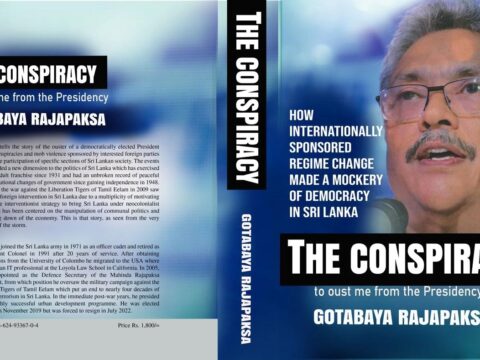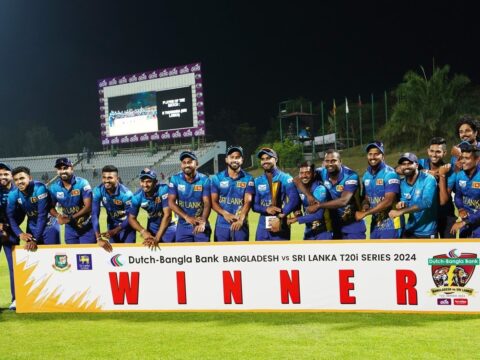COLOMBO: In the four months leading up to July 9 toppling of Sri Lanka’s former president Gotabaya Rajapaksa, a protest village formed in Colombo, occupying the capital city’s oceanside park Galle Face Green. Called Gota Go Gama (GGG), a mashup of Sinhala and English words meaning “Gotabaya Go Village,” it became the main gathering site for aragalaya, or the struggle. A space of national imagining, GGG has been shaped by the contributions of artists expressing their frustrations and aspirations as part of a peaceful movement of citizens voicing their dissent. But in the middle of the night on July 21, less than 24 hours after Ranil Wickremesinghe was sworn in as the country’s new president, he ordered a military crackdown on GGG.
Sri Lankans have endured a crippling economic crisis, with fuel and food prices skyrocketing. The country’s lucrative tourism industry has taken a major hit since the onset of the pandemic, but it was the mismanagement of resources by the Rajapaksa administration that ultimately fueled this backlash that led to his ouster.
Almost as soon as GGG took root it began to feature the works of visual artists. An art gallery formed and the feminist public art project Fearless Collective erected a mural on a standing wooden flat. Tehani Ariyaratne, the chief operating officer of Fearless, wrote in a recent email that “the sense we got, painting in the art space at GGG, was that art was being used as a powerful medium of resistance and to express the feelings of the protestors at the site.”
While protestors’ anger was reflected in much of the art on view at GGG, the Fearless mural, which was collaboratively painted by local artists, set out to visualize the possibilities of a new country emerging from aragalaya. The mural depicts four figures that embody the qualities the painters want in their leaders, with each displaying a symbol of an attribute: a flower in the hair for compassion, a scale for justice, rice plants for abundance, and a clay oil lamp for mobility. The Fearless artists created a place of hope and joy around the work, which Ariyaratne recalls was intentionally filled with music and laughter.

Vasi Samudra Devi helped conceptualize and paint the mural. A trans-woman artist and activist, Devi was involved in organizing the country’s first ever pride march, which took place in Colombo this past June. (Homosexuality is still criminalized in Sri Lanka, under a penal code dating to 1883 that was established during British colonial rule.) Devi’s own paintings have become more abstract as she’s begun creating works publicly at GGG, and a major inspiration for this was when she painted deconstructed pride flags on the bodies of allies during the pride march.
Devi said that the immediacy and public nature of painting on bodies has influenced how she works on canvas, as has working en plein air, during which she dances and lip syncs with those gathered. Titled “Polycule,” her series of paintings made at GGG combine bright, flowing forms with the musculature of the human body to illustrate the vibrant fluidity of sexuality. Though representations of political insignia or depictions of violence don’t appear in the paintings, Devi stresses that they are, indeed, political, as they emerge from the conditions of struggle and oriented toward the future, visualizing what the artist hopes to see in her country one day.
Natasha Ginwala, a closely watched curator on the international biennial scene who splits her time between Colombo and Berlin, has been involved in COLOMBOSCOPE, the city’s biannual arts festival, since 2015. She recently wrote about artist actions she witnessed at the protests, describing a projection of the words “No More Corruption” on the facade of the Presidential Secretariat and artist-led ritual dance processions to symbolize the exorcism of the government’s wrongdoing. In an interview, Ginwala pointed to the importance of collective public actions and stressed how this has also been a time of reflection for many Sri Lankan artists, as well as taking care of oneself and one’s peers, which she called a form of “invisible labor.” Artists are doing the valuable work of “watching, observing, and being open to a genuine reformulation” of the country’s social and political structures, she said. “The pressure of collapsing systems is huge, so how to continue, reimagine, and sustain creative efforts in the face of repeated political failures and economic ruin” is crucial, Ginwala added.
Reflection seems to be the current mood of cultural practitioners across Sri Lanka. Colombo-based poet Imaad Majeed recently spent time with Muslim and Tamil minority populations outside the capital city for a project that showed at COLOMBOSCOPE in January. With their collaborators from the publishing platform The Packet, Majeed made Testimony of the Disappeared (2021–22), which featured drawings and concrete poetry made from the public testimonies from the activist group, the Mothers of the Disappeared, who have been seeking justice for loved ones killed or missing since onset of the country’s civil war in the 1980s. The project emerged out of the lack of national attention toward protests against the Rajapaksa regime last year, when thousands of people marched in a Tamil-speaking northeastern province calling for the government to account for its atrocities committed during the 30-year civil war that ended in 2009. Among those were the heavy bombing of areas controlled by the separatist group the Liberation Tigers of Tamil Eelam (LTTE), which resulted in the deaths and disappearances of thousands of civilians.
Part of the Testimony of the Disappeared’s motivation is to encourage those in the aragalaya movement to focus beyond economic strife to include the concerns of all Sri Lankans, including the grievances of minority groups. “Now that something has been accomplished by getting Gotabaya out, I feel I would have more faith in the movement if it seeks to transform the structure of Sri Lankan state and what it can accommodate,” Majeed said. Amending the constitution to move away from a majoritarian democracy and reimagining a flag that recognizes all of the country’s ethnic groups are places to start. Majeed emphasized that if justice for past atrocities isn’t achieved, another separatist group, like the LTTE, may form.
Given the lack of public transport to get to the protest village and personal responsibilities, artists like Hema Shironi, who moved to the suburbs of Colombo shortly after becoming a mother in 2021, have been making work at home. Working primarily with fabric scraps, Shironi said she is well positioned to make art during a period of scarcity. In her mixed media sculpture Cage Free and Proud (2020), a piece of cement rubble is surrounded by a mesh cage. Shironi has embroidered the cage with the insignia of the India housing project for rebuilding homes in Killinochi in the north, which was a battleground city during the civil war. Her extended family fled the city during the war, but have since returned and have found these new uniformed homes to be unappealing.
Though she is not creating works that directly refer to the protests, Shironi said all her art comes from her experiences in the country’s political climate. They are, therefore, inherently connected to this struggle, and pursuing intricate designs and embroidery is her way of feeling involved in this collective action. In her words: “Everything is based on these protests. I am not making new pieces about the protests, I am pursuing my own stories and my experience, but what I am making at home is connected.”
© ARTNews




